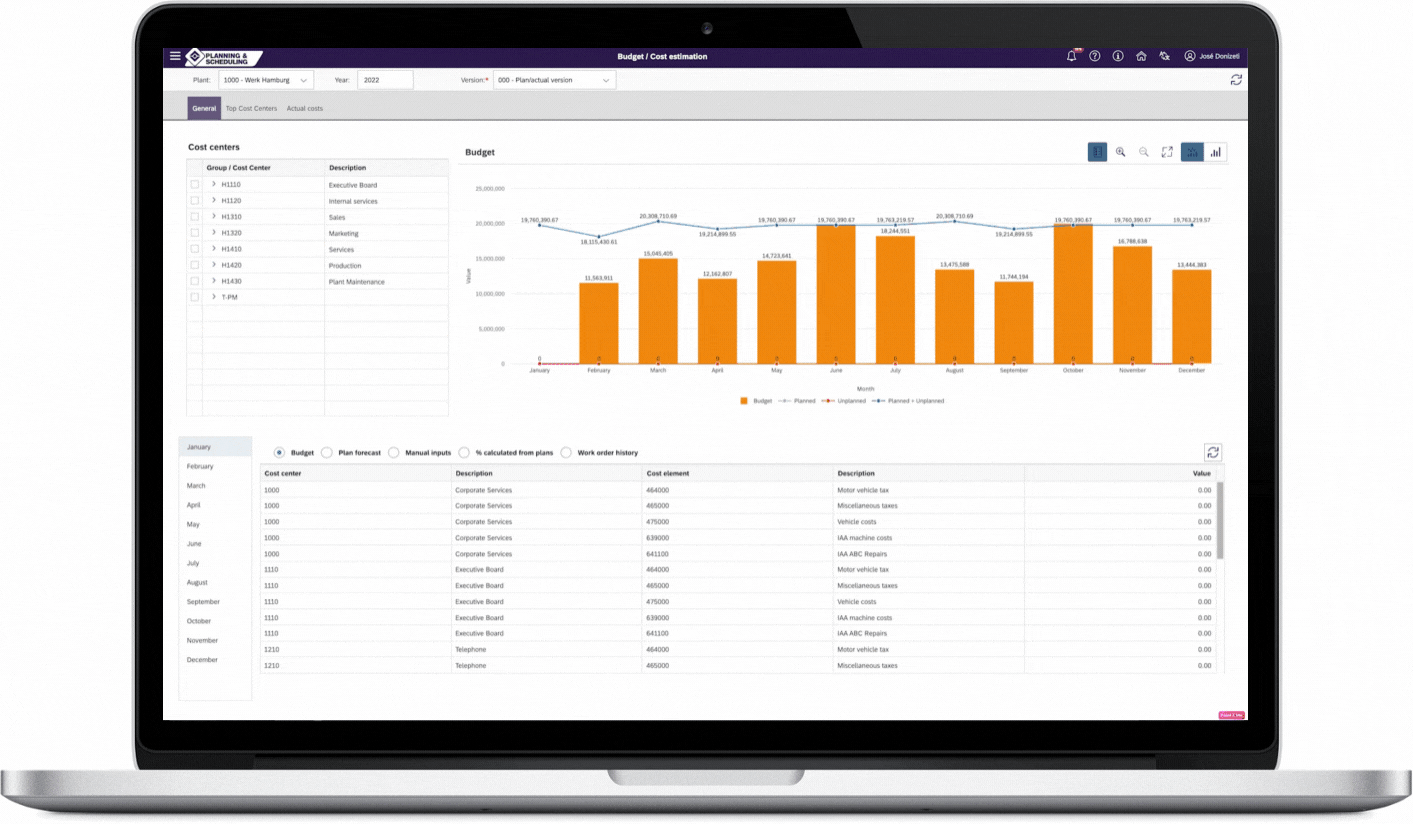Increase Budget Control for Strategic Maintenance Management
November 23, 2021In many ways, maintenanceis one of the most importantfunctionswithin an organization. It has the potential to impact everything from production to customer service. Yet manyoperationsmanagerslack the tools and data that they need tostrategicallyplan and budget for maintenance operations.Creatingadata-drivenplan from SAP EAM requirescountless hoursofmanipulatingvolumes of transactiondetailsin spreadsheets.Eventhen, the data qualitycan inhibitdrawing insights to build a solid plan.Organizations can overcome these limitations and improve theirannualmaintenance planning and budgeting processes by augmenting SAP withtoday’s automation capabilities.
In this article, we willexplore thebudget creation and trackingchallenges andthenhighlightopportunities toimprove process efficiency and accuracy formore strategicmaintenance management.
>Budgeting forStrategic Maintenance Management
Effective maintenancebudgetmanagementisvital to the success ofasset-intensiveorganizations.Havingthe resources in people and materialsto maintain assets and respond quickly toresolve issues that arisecan have a material impact toproduction. Minimizing unplanneddowntimeand ensuring that assets are running at peak efficiencyresults inhigher levels of production andbettermeeting customer needs.According to Forbes, unplanned downtime is “one of the largest causes of lost productivity, causing delays, unhappy customers and lost revenue. In fact, the problem costs industrial manufacturers an estimated $50 billion each year, according to recent studies.”
Not only do you need toplan forthe resources, but you need toplan forthe right resources andoptimize your costs against budget realities. Andthisis the fundamentaltask toaddress.
Challenges of Using SAP EAM Data for Budget Management
Developing an annual maintenance budget and tracking actual expenses throughout the year are core components of effective maintenance budget management. ButSAP is well known tobe challengingto work with for many processes of maintenance planning and scheduling. Creating and tracking spend to an annual budget plan is certainly one of those processes. Let’s explore these challenges.
>Tedious and Inefficient
The process of developing a bottoms-up annual budget starts with extracting maintenance data from SAP. This includes every PM task from the maintenance plan and historical corrective and breakdown work orders. Then working with spreadsheets, arrange the expected planned work over the year, add an estimation of unplanned maintenance based on history, and then add any ad hoc projects expected to occur.
Thisdata manipulationprocess can take many days or even weeks and takestimeaway frommorestrategic maintenance management activities.This may be o.k. for a once-a-year exercise, but the work to view the actual costs to the budgettakes almostas much time every month.
>Organizing the Data for Finance and Others
As a major cost center,deliveringan accurateestimation of spend isimportant to thewholeorganization.Different stakeholders will want to understand what’s behind the budget and what are the trade-offs to meet company expense goals.
For Finance, they will want to review the budget by the appropriate general ledger accounts or other corporate cost structures. Breaking down the work orders (for example parts, labor, and contract labor) and organizing the budget views by these categories brings a whole new level of data manipulation that often proves too time-consuming to even attempt to do.
For Plant and Maintenance Managers, they will want to see and manage the budget by their locations, cost centers, or even at the asset level.
Compiling different iterationsof the budget to help different decision-makersis importantbut almost impossible to accomplish for annual planning orongoingviewingofactuals to the budget. This limitseffective maintenance managementtasks including:
- Planningfuture requirements includingnumber of techniciansby craft,andparts and materialsto source inthe next year
- Expected spend as well as tracking actuals to the budget to show where the money is going
- Availability of detailsto support budgetandactivity trade-off discussions
>Data Quality
SAP PM dataneeds to be completeand consistent to support analysis by any method – spreadsheets or automation tools.If your SAP PM data is fed by manual data entry of completed paper-based work orders, the datacan be incomplete and containunstructured data entries such as open text reasons for failure. These issuesmake analysis difficultincluding organizing and viewing the history data to understandcorrective vs.preventive maintenancecostsor identify “bad actors”such asassets that areprovingcostly to maintain.
Overcome Challenges with Automation
To improve the maintenance planning and budgeting processes, organizations need to augment SAP with a tool that automates the extraction and sorting of data. The solution should also enable informed decision-making through data visualization tools as well as streamline communicationto differentstakeholders.
>Automation toOrganize SAP Data
A maintenancebudgetingsolution cantake days and weeks out of the planning process by automating the process of extracting SAPPM plans and work order history to createabottom-upbudget.Uploadthe organization’s budget expectations and compare the results.From this starting point, you canwork to align the results to the budget byadjustingseasonality, add special projects,and addcontingenciesorreserves.You can alsoevaluate themajorcost drivers to determinewhere to cut or make trade-offs.
>Arranging Budget Views by Audience
Automation can also create views bydifferent audiences from Finance to Plant Managers.Importorganizationalcoststructurelistssuch as cost centers, general ledger accounts, cost elements,plant locations,and assets tosort thebudgetingdetails.You can evaluate and adjust the budget based on your views, then rearrange and upload the budget toSAP oranotherfinancial accountingsystembased on their views.
>Manage Spend Throughoutthe Year
Once you have aligned on an annual maintenance budget, you can trackactual spend to the budget using the same solution. On a regular basis, a budgeting solution canpull the latest SAP data to evaluate actual spending and forecastchangesbased onthe latestSAP PM plans.
>Improve Data Quality for Budgeting
To ensure thatyour budget plans are based on good data,improve the capture and structure of work order results details.Replacing paper-based work orders with aMobile EAM solutionwillquicklyimprove the quality and completeness of the data captured.This will enable an analysisof work order history for budgeting and fact-basedbudget-cutting andtrade-off discussions.
The Benefits of a Maintenance Planning and Budgeting Solution
In summary,amaintenance planning and budgeting solution that is designed to work with SAP offers many benefitsthat make it worth the investment.
>Time Savings for Managers
The time savings can besignificant in the annual budgeting process down tomanyday-to-dayactivities of your valuable seniormaintenance managers. Consider the timesavings from replacing tedious data extraction and spreadsheet workto create budgets and track spending. Then look at the work behindorganizing the plans and status updatestoeachstakeholderfor their needs and processes.In addition,considerhow much timeit takes today to get at the datatounderstand andexplain where the money is going and why you are under or over-budget.
These time-savings can free up yourleadershipteam for driving strategic insights from the data to better manage the organization formorecost effective maintenance management.
>ImproveControl onMaintenanceSpend
You can control maintenance spending through advanced planning. With full visibility of your resource needs, you can proactively address those needs. For example, your annual maintenance and budget plan will showthe people resources you need by craft to fulfill the plan.With this insight, you candetermine if you need to hire employees, contractors, or make sure you have the funds to supportthe costs of overtime.
You can also reduce inventory carrying costs byadvanced planning of the parts and materials you will need for the plan. Avoidcarrying too much inventory or under-orderingwhich canresultin costlyrush shipping of repair parts.
From an on-going perspective, you have the visibility to spendingthrough the year toadjustas needed to stay on budget oracquire the funding needed.With no surprises, you are in control.
>Improve Visibility toMaintenance Costs
Also, with these decision tools, you can have a fact-based conversation about the trade-offs to manage the budget. For example, you can simulate the impact of covering the headcount needs with contractors instead of overtime, or the cost of risking repairs from reducing PM tasks.
>Adding it Up
Annual maintenance planning and budgeting play an incredibly important rolefor asset-intensiveorganizations. Buttoday’smanual processes and inefficiencies with SAP lead to many challengestocreateand manage budgets.
AugmentingSAP’s capabilities with a maintenance planning and budgeting solution can help overcome these challenges.Gain the benefit of a bottoms-up budget thatsupports insights and decision-making.Track and report budget status to key stakeholders, like Plant Management and Finance in views that meet their needs.Planrequirementsand control spendingthrough the yearwith full awareness ofthestatus andimplications.
Reap thesebenefits of morestrategic maintenance managementand morewithtoday’s solutions to optimize working with SAP.
>How Sigga Can Help
Sigga has been helping companieswith SAP toimprovemaintenance managementfor two decades.We offer an industry-leadingPlanning and Schedulingsolution that integrates seamlessly with SAP. The solution gives planners and schedulers access to accurate and complete data in real-time. Moreover, they have access to powerful features such as the ability to automatically check capacities, assign resources, and prioritize work orders that saves time and boost efficiency.
Andnow, weoffer amaintenance budget module toaddress the annualmaintenanceplanningand budgetingprocess. This module includes features to:
- Create an annualbudgetplanandidentifyresource requirements from SAP PM plans, work orderhistory, and custom inputs
- Identify resource gaps, the biggest budget offenders, and distortions between capital and expected spend
- Providesviews by cost centers, cost elements,andplants
- Keep everything integrated with SAP and with other financial systems
- Track actual versus planned spending
In addition, we offertwo integrated mobile solutions toreplace paper andkeep data digital and visible across the enterprise.Sigga Mobile EAMsupports the day-to-day tasks of maintenance technicians whileSigga Mobile Warehouse and Inventoryaddresses theday-to-daywork within warehouse operations. Both solutions arehigh-performance,native mobile apps that supportboth online and offline use,pluscomplete access to phone functionssuch as barcodes and camera.
>Read how we can help you improve your maintenance planning and budgeting processes.

